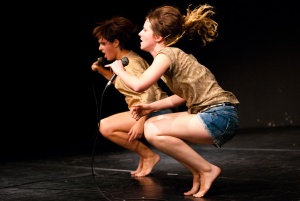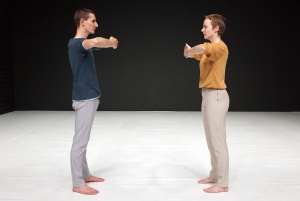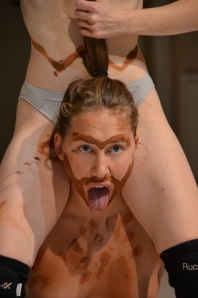
I Description
The performance is in the form of a circuit situated in a horticultural nursery on the outskirts of Cologne. The circuit consists of three buildings whose interiors are divided and semanticised during the course of the performance: a big, brick-walled greenhouse, a small glass greenhouse and a hothouse with a solid sliding door and side sheets. These buildings are at right angles to one another, with the small glass greenhouse, about 2x3m, at the intersection.
The performance begins at the front of the large brick greenhouse. The five female performers – all “experts in everyday life” – plant flowerpots lined on a trolley, each bearing a sign. On each pot is a label for different gender identities, key concepts of gender studies, names from queer culture, general expressions of uncertainty, symbols and lettering in Bengali. Each of the small flowerpots is planted together with a colourful piece of candy: “Take a goody – take a fixation”, the installation seems to say, “Both are sweet – and neither are natural”.
After the flowerpots are planted, the five performers move to their respective positions, among which the audience can move freely and decide for themselves where and when to enter and leave the on-going performances (I also jumped from one place to the next, meaning that the following cannot be a full representation of what was going on).
Annonya and Katha stay at the large greenhouse. They are both hijra, representatives and activists of the “third gender” in Bangladesh, and trained dancers. They begin by presenting the hijra culture from its ritual colourful side. Flanked by two canvases showing films from their everyday lives and urban and rural street life, along with familiar religious moments, they erect a ritual space with silver vase-like vessels and colourful gift boxes, lining it with Bengali lettering in flower potting soil. Here they dress in traditional garments, speak and sing into microphones, thereby illustrating the traditional role of the third gender of blessing families at weddings, house-warming celebrations and births of children. There is something double-edged about the processes throughout; the performers seem ironically distanced and at some point a shifting occurs that is unavoidable if the hijra are not to be idealised but realistically portrayed: the pictorial Bengali façade breaks. The performers move towards the audience, clapping. “Hey, hey, hey, we’re hijra. We’re poor, give us some money”. They leave the ritual space. In a monotone green-planted part of the greenhouse, Katha erects upside-down hammers, sheathing the stems with condoms. She plants the colourful Bengali condom packaging amid the green monoculture. Poverty and forced prostitution: the dark side of the otherwise colourful third gender, which in modern secularised Bengali culture has no alternative income. Katha is instructed in her sheathing of the hammers by Annonya, who (we learn from the performer biography in the programme) also works as an activist and sex worker consultant in Bangladesh.
At the end of their multi-faceted performances and stories, the two dancers move into a tent located in front of the large greenhouse, where they prepare food on gas stoves and eat until the end of the event: a working day consisting of conversation, feast, charity, education and paid sex reaches its humble end.
In the second position, the small greenhouse, there is a red sofa. Here, Cuban native Melissa Marie García Noriega tells the story of her life – sometimes face-to-face, sometimes simply lost in her own thoughts. A carefree childhood, in which no one was bothered by the boy behaving girlishly; then a rape, the knowledge that the girl in her had been abused; a lack of family acceptance of her feminine demeanour at puberty, the grotesque urge to become a Cuban macho, then, finally, deliverance. Art studies, psychotherapy, the birth of a son, the possibilities of a new self-determination in living with a man and eventually her sex change to become the woman she had already been. Melissa still lives with the same partner; the audience is caught up in the sweet relief of a happy ending. During all these stories, which may have given rise to either concern among the audience or, even worse, the feeling of psychotherapeutic authority, the dancer and choreographer succeeds in remaining dominant throughout. The red couch is not a Freudian spot for self-exposure, but an arena in which Melissa moves through gloom, aggression, ironic poses, excitement and truly refreshing directness. The amiability that she arouses in doing so, the self-confidence that she exudes, catches the audience and turns it into a close friend – and if there were not the other “stages” yet to visit, one would stay to listen to her much longer.
Melissa’s story alternates between her experiences in Cuba and Germany, the greenhouse serving as an intercultural intersection which connects the Bengali scenery in the large greenhouse with that in the hothouse opposite. The latter are dedicated to gender approaches in Western culture. Initially, the sliding door of the hothouse is open and we see earth grooves in the fore room, jackets on hangers above. In perspective, the “asparagus field” – masculine connotation attended – stretches out into a monoculture of pansies. The trained mathematician and physicist Michelle Niwicho begins to label the sliding doors with the milestones of her life. Then she closes the door from the inside and it takes a while before the audience discovers that they are not locked out, but can observe the interior through the rolled-up sheets at the side. At first, one feels forced to a voyeurism, but the inner actions soon clarify that the opposite is the case. There is a need for the construction of this interior, or rather, this inner life, in order that messages may be sent out of this mentality of security.
Michelle constructs her workplace: desktop, laptop, mouse. Here (as in real life) she writes a blog that can be read both on the PC screen, and on the canvas located at the inner side of the sliding door. The text is about the decision to live as a transgender woman, about the problems arising from the fact of being a father of three when she finally came out, of the bureaucratic difficulties of being recognised as a third gender in Germany; but also about acceptance in one’s own family, managing one’s career, rising assertiveness and wonderfully grotesque moments of everyday life. Following Michelle’s words as she writes, her correction of spelling errors, the search for the right phrases, produces a similar emotional closeness as to the life story told by Melissa in her greenhouse.
While she writes, Michelle gets up and with a pair of pliers cuts the wires holding the jackets one by one, letting them fall to the ground. Every time a male garment is removed, she pulls a cord, and female clothes grow from the asparagus beds... like Spartoi springing from dragon’s teeth: the ancient warriors of Thebes – the modern struggle of the transgender woman.
At the back, in a field of yellow blooming pansies (also cropped with high heels), the Brazilian performer Greta Pimenta removes her female clothing and puts it on hangers, much like the jackets at the front. She showers naked for almost the entire performance and presents her female body with male genitals. She remains silent throughout. As always when an audience is confronted with nudity, there is irritation, and the mixture of sexual markers certainly intensifies this. But the fact that the performer is naked for over an hour, in which she never gives the impression of being watched or feeling embarrassed, alters the perception of her bi-gender body to a normality: it belongs – to both the performance and the utopia of a free society.
As a whole, the two areas of the hothouse function as the union of two aspects of transgenderness: Michelle’s intellectual approach, which does not shy away from self-doubt, and Greta’s unquestionable confidence: two states of an inner life, intellect and body, which is presented to the audience with a permissiveness that annihilates the exploitative habit of voyeurism.
II Relation to spatial theory
The production convincingly works with the cultural semantisation of the physical structures: the “otherness” of the Bengali hijra in the large greenhouse, the link of interculturality in the smaller greenhouse, and one’s “own” culture in the hothouse, all logically connected on a circuit through which the audience is allowed to wander freely. The venue thereby becomes the representation of a larger circuit or (according to Foucault), a Heterotopia, which draws opposite and remote elements together in a microcosm representing the whole.
Another interpretation is provided through the performers’ biographies, which form one of the fundaments of the production. The individual nature of these prohibits any cultural generalization. There is a variety of body concepts depending on the individual performer and his cultural frame, reaching from the mythical connotations but social exclusion of third genderness, to hormone treatment and finding deliverance in the revised body, textural reflections of the gender shift and the self-confident presentation of both sexes in one body. All of this is presented to the audience not in a brash, but in a quiet, sensitive, humorous, thoughtful and very rich visual appearance. And with this, transsexualism proves itself to be far “more natural” than the dominant heteronormativity and sexual binarity of our society. This allows an intercultural and transgender discourse to be personally experienced, intellectually as well as emotionally. An experience like this makes it clear that talking merely about the third gender is not enough to achieve an acceptance that includes all aspects of sexual versatility.
The spatial semantics of the place itself, the municipal horticultural nursery, is an elementary constituent of this combination of interculturality and transsexuality: the greenhouse as the epitome of our “will to breed”, of the artificial and authoritarian compulsion to frantically produce normativity: a non-place in the pejorative sense, deindividualising and alienating (Augé); monocultures as symbols of a society that wraps a hostile tristesse around non-conforming bodies, compelling them to adapt. But in the end, these bodies look more natural in the eyes of the audience than the compulsive order of “asparagus vs. pansies”. Thus, the imagery of the performance generates an effect of great sustainability in the viewer’s mind, giving her/him a glimpse of utopia.
Also, the production cleverly points beyond the confines of the nursery, as it stands in the shadow of the phallus-like tower of Cologne-Poll’s Technical Control Centre (TÜV). This is not just a place for general (and in this case typical German) normalisation, but had also been the birthplace of the DIN standards for breast implants – a cradle of normalised gender features which the colourful activities of ID-Clash contrasts with the image of versatile self-determination. If one adds the sadness of the adjacent monotonous rows of graves of the Deutzer cemetery or even the nearby (and even more German) allotments with its garden gnomes (including pompously phallic jelly bag caps), it becomes clear that a better location can hardly be imagined for this performance.
In addition, it is worth noting that the 1st of November 2013 finally saw the “third gender” legally recognized in Germany: Hiesl and Kaiser’s performance, which is to run again in Dresden in 2015, can be seen as a celebration of this event. Or better still, an accompanying ritual, which converts the deindividualising place of monoculture and gender norms into an utopian space of intercultural and transgendered freedom.
Picture: Cologne 2013. © Roland Kaiser




